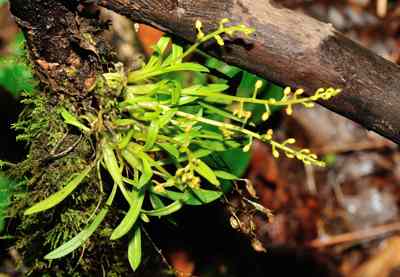The Plant
Epiphyte. Pseudo stems small, compressed, fleshy, 1.5 to 3 cm long and 0.6 cm in width, arising close together. Stem with many thick long roots arising from its base. Leaf 3 to 5 arising from the apex of the stem circling it, oblong, erect, 2 to 6 cm long and less than 1 cm in width, apex pointed, base sessile, with many of them slightly curved towards their apex. Flower small, many in an erect inflorescence arising from the apex of the stem surrounded by the leaves. Inflorescence almost twice longer than the longest leaf of each plant, cylindrical, ribbed, fleshy.
The Flower
Flower less than 1 cm across. Sepals un-equal, oblong and with blunt apex. Dorsal erect, longer than the lateral. Lateral sepals wider than the dorsal, diagonally spreading. Petals linear to oblong, longer and much narrow than the sepals, arranged pointing downwards across the pedicel. Lip deflexed at the middle, deeply grooved from base to apex, margins wavy. Floral bract erect, shorter than the long pedicelled ovary, diminishing in length towards the apex of the inflorescence, arising from the lower base of the pedicel.
Flower brownish yellow to pale yellow. Floral bract green.

The Pursuit
I had found this species for three continuous years that too from three different locations. Of the three finds, the first one was the most thrilling; hence that pursuit story is described here.
With the alpine flower hunt I moved to high mountains by the mid of June. The trip got delayed by 15 days due to inclement weather and roadblocks caused by heavy rains. As that was my first alpine pursuit, it took a few days for me to get adjusted with the climatic conditions of the high mountains. However, I was blessed to find a very good person to assist me in the field. Even though he never ventured deep inside the forests of the region, he was aware about few trek routes that crisscross the forests.
In the first week itself, he took me to a very dense forested hill, which was higher in altitude than the place of my stay. Even though the uphill climb was very tedious, the dense forest was home to many species. Hence every other day we made a visit to those forests. After a week of sunny days the weather changed to heavy to very heavy rains. It rained continuously for 6 days. I was really upset about the weather conditions. The loss of a week during those peak flowering season was going to bring a big impact in my whole strategy. Finally, on the seventh day rain clouds cleared to make way for the Sun.
We took the uphill climb again looking for more species. As we were surveying the area, rain clouds appeared from nowhere and it started raining heavily. Even though we were prepared with raincoats and rain covers for the camera bag, we both were awe struck because of the sudden and intense rain. My friend guided me through that heavy rains and we took shelter under the trunk of a fallen tree. The tree was huge and very old with its main trunk more than 2 m in diameter under which we were well protected from the heavy showers. The only discomfort was that we both had to sit on our knees.
As time went by I started scanning the tree trunk and its broken branches for any possible species. To my surprise I found a small bunch of this species right next to where I was sitting, a small bunch of around 12 to 15 plants. This species is so small; even 12 to 15 plants occupy hardly few centimeters. Its peculiar stem shape and leaf arrangements made me instantly identify the species. My friend also spotted the species but advised me to wait for the rains to stop. He was more eager than me to safe guard my camera equipments from rainwaters and also to protect both of us from getting wet. We waited for another 4 hours for the rains to stop. However, there was no sign of it stopping. As it started to get dark we descended the hills with the help of walking sticks made from the branches of that fallen tree. It took more than 3 hours to reach downhill, a distance we normally cover in 40 minutes. The next week plans also got washed away in heavy rains.
On the 9th day we were able to start surveying again and we went straight to the dense forested hill and to the fallen tree. I spotted the same bunch that we encountered on the previous rainy day. The plants were as the same, no buds or flowers. But, my inner mind said that there was a possibility to find more of the species. We both surveyed the whole fallen tree for the next 45 minutes to find seven bunches of the species, three of them in full bloom. But, the heavy showers of the previous days made the flowers water soaked and rotten. With great difficulty I selected a couple of flowers and documented them for the sake of presentation. Even though in the next weeks and months of my Alpine days I searched for this plant in various locations in vain.
In the following year I found the plant again from another location, this time with fresh and beautiful flowers and I was able to produce some great photographs of it.
Reference:
King, G. & Pantling, R. (1898). The Orchids of the Sikkim-Himalayas. Ann. Roy. Bot. Garden. (Calcutta). Liparis perpusilla Hook., Page no 33.